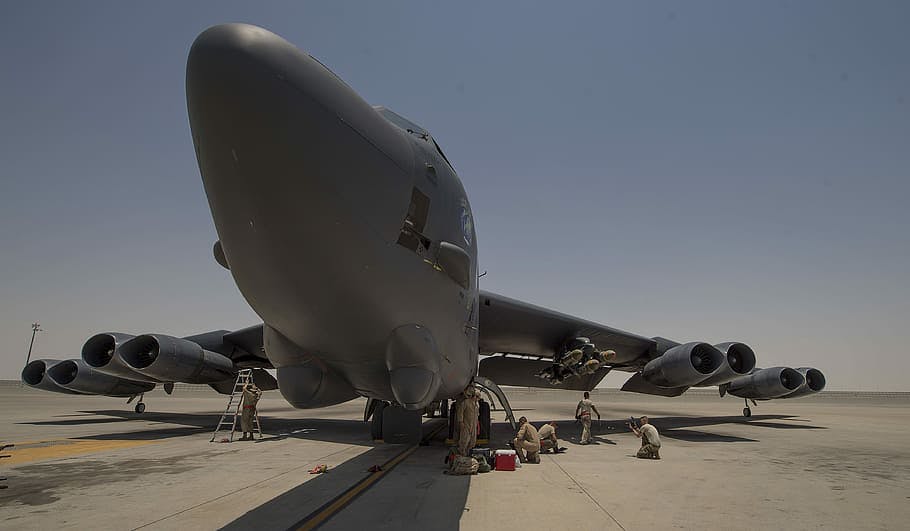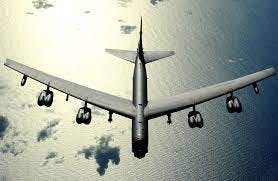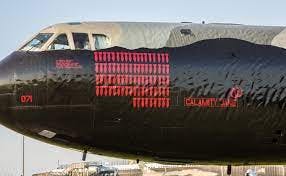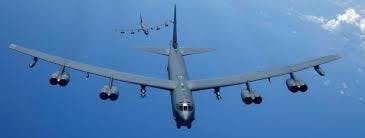B-52 Stratofortress: Raining down hate since 1954, and getting better with age

Blog
If you try to think of a piece of military equipment, ANY piece of equipment, that’s been in continual service since the mid-1950s, there are only a handful of options. John Moses Browning’s game-changing .50-caliber M2 machine gun has been laying waste to Messerschmitts, terrorists, and other baddies since 1921. There are a couple of Caterpillar bulldozer designs that the US Army first put into service in the late 1930s and is still using. And the US is still using smoke grenades and land mines that haven’t changed much since the early 1950s. But when it comes to big, complicated flying machines in front-line service, nothing comes close to the iconic B-52 Stratofortress long-range heavy bomber, first entering service in 1954.
Let’s see if we can shed some light on what makes the largest jet-powered bomber so timeless.

The Cold-War need for a long-range nuclear bomber
In late 1945, the Air Materiel Command put out a request for a new strategic bomber that wouldn’t need to rely on advanced or forward bases in other countries for support. This meant it needed very long range. Interestingly, the B-52 is very different from the original design for which Boeing won the contract in early 1946, which was a straight-wing, 6-engine turboprop design with a gross weight of 360,000 pounds.
In the early jet age, advances in engines, advanced alloys, and aerodynamics were being made nearly weekly, and the military realized that the new bomber, if maintained in its first state of design, would be obsolete before it would even enter service. Initial design requests (and the initial contract) were for a bomber with a cruise speed of 300 mph and a range of 5,000 miles, but within months this was raised to 400 mph and a range of 12,000 miles. As the requirements changed, several designs were submitted, including 4-engine turboprops with straight and swept wings. After the project was put on hold, Boeing continued to refine their design to meet the most current requirements, only to learn that the US military bigwigs had again changed their minds, now requiring a top speed of 500 mph and a range of 8,000 miles.
Back-and-forth revisions and suggestions continued for several years, with the primary argument being between turboprop engines and turbojets. The turbojets of the day were not particularly efficient, which limited the range of the new bomber. However, General LeMay, head of Strategic Air Command (SAC), argued in favor of the higher-performance jet engines, reasoning that the range problems could be solved with improvements to the airframe later. In response, Boeing’s designers increased the overall size of the aircraft so it could carry more fuel. LeMay also insisted that the proposed tandem pilot/co-pilot arrangement be modified to a side-by-side arrangement to reduce pilot fatigue and improve morale on long flights. Boeing was awarded a production contract for thirteen B-52As on February 14, 1951. The prototype first flew on April 15, 1952.
On January 16-18 1957, three USAF B-52s conducted Operation Power Flite, setting a record for the first jet-powered non-stop flight around the world, in 45 hours 19 minutes. The three aircraft flew at an average speed of 525 miles per hour.
Taking advantage of the B-52’s ability to utilize in-flight refueling, the circumnavigation exercise was intended to display the USA’s ability to drop the hydrogen bomb anywhere in the world. Famously, from 1960 to 1968, B-52 aircraft armed with thermonuclear weapons were maintained in continuous airborne alert, 24 hours a day, near the USSR’s northern border, including up to 12 flights daily from different airbases. This was called Operation Chrome Dome.
Upgrades over the years have improved fuel capacity, range, speed, avionics, radar, engines, and electronic warfare capabilities.
In all, 744 B-52s were built in 8 major variants, and there are around 76 still in active service, all of the latest, 1962-era B-52H variety. However, even these are due for extensive, expensive upgrades to keep them viable until the 2050s. More on this below.

What are the specifications and performance of the B-52 Stratofortress?
These numbers reflect the latest B-52H configuration. Wingspan is an enormous 185 ft (56.4 m). Length is just over 159 ft (48.5 m). The B-52H is over 40 ft (12.4 m) high at the tail and weighs 85,000 lb (83,250 kg) empty, with a gross weight of 265,000 lb (120,000 kg). Maximum takeoff weight is 488,000 lb (221,323 kg), including 70,000 pounds (32,000 kg) of bombs or mixed ordnance. Fuel capacity is 47,975 gallons.
With the latest Pratt & Whitney TF-33 turbofans, the B-52’s maximum speed is 650 mph (1,050 kph), with an impressive (compared to initial expectations) cruise speed of 509 mph (819 kph) and a combat range of 8,800 miles (14,200 km) without refueling.

What is the B-52 used for?
As mentioned above, the Boeing B-52 was originally conceived as the Cold War heated up in the late 1940s and early ‘50s, when the US saw the need for a fleet of long-range heavy bombers capable of delivering one of Dr. Oppenheimer’s nuclear offspring deep into the heart of Mother Russia.
However, despite Slim Pickens’ famous depiction to the contrary, the B-52 never dropped a nuclear device in anger (thankfully). Instead, the B-52 aircraft has been used primarily as a heavy conventional bomber (most notably during the Vietnam conflict, including the controversial Operation Linebacker II, when more than 200 B-52s flew 730 sorties and dropped over 20,000 tons of bombs on North Vietnam over a period of 12 days in December 1972).
However, B-52s also delivered 40 percent of all the weapons dropped by coalition forces during Operation Desert Storm, and the updated Stratofortress fleet is used today for strategic attacks, air interdiction, close-air support, maritime operations, and offensive counter-air missions, as well as a platform for launching modern cruise missiles and other smart weapons.

How much did a B-52 cost to produce, and what is the CERP?
1955 numbers state that the development cost of the B-52 program was $100 million, or around $1.14 billion, adjusted for inflation. The Air Force says that the per-unit cost of a B-52 Stratofortress was $9.28 million in 1962, or around $94 million in today’s Monopoly money. Compared to the 1990s’ B-2 stealth bomber at $1.8 billion per copy (that’s billion with a B) in adjusted dollars, and you can start to understand why the still-functional, still effective B-52 makes a lot of sense to fly, even though the last one was built in early 1962.
However, when you consider the 70-year length of continual service of the aircraft, the B-52’s relative value is even more impressive.
The Commercial Engine Replacement Program, or CERP, is the Air Force’s plan to replace the B-52Hs Pratt & Whitney TF33 engines with new, more reliable, more efficient, and more powerful Rolls-Royce F130 engines, resulting in the B-52J. The engines will be digitally controlled, requiring new pylons, new twin-engine nacelles, and wiring to connect the powerplants to the B-52’s upgraded cockpit.
In 2022 the Air Force stated that the total cost of the CERP upgrades is still somewhat up in the air (pun intended), but 2021 estimates were at least $11 billion. We’re speculating that the final cost will likely be around $15 billion after supply-chain issues and program adjustments have been made. However, the CERP is part of an overall modernization of the B-52 fleet that includes new digital wiring, communications, and flight systems, among other improvements.
Another planned upgrade to modernize the B-52’s radar will dramatically improve the bomber’s situational awareness and ability to accurately strike targets, according to the Air Force.
Wired reports, “On the weapons front, the airplanes are due to receive weapons-bay upgrades, enabling them to hold more smart bombs, and radar enhancements, potentially including the Active Electronically Scanned Array Systems technology. Used by fighter jets like the F-22 Raptor, the digital radar system is vastly more precise and offers higher resolution than conventional radar dishes. (It’s also expensive and complicated, so aircraft are receiving them selectively, based on their mission demands.) The B-52s are also getting something called Link 16, a tactical data system that will boost targeting capabilities in-flight, based on input from ground forces and other aircraft.”
Projections are to keep the updated B-52J in services into the 2050s, but Lt. Gen. Richard Moore, the Air Force’s deputy chief of staff for plans and programs, is remaining cagey about whether the Air Force is planning for a new “clean sheet” strategic bomber to replace the B-52 in the coming decades, as well as how many B-21 Raiders the Air Force will be buying. However, it seems clear the venerable B-52 will be kickin’ ass and takin’ names for several decades to come.
Talk about getting your money’s worth!
–By Jeff Davis, Intergalactic Scribe
Sources:
https://www.airandspaceforces.com/cost-of-b-52-re-engining-jumps-by-half-in-new-estimates-of-refit/
https://www.cnet.com/pictures/the-b-52-bomber-turns-60-photos/2/
https://nationalinterest.org/blog/buzz/5-longest-serving-military-aircraft-us-air-force-177412
https://www.wired.com/2016/04/gods-green-earth-b-52-still-service/
https://www.af.mil/About-Us/Fact-Sheets/Display/Article/104465/b-52h-stratofortress/